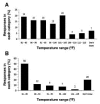Diabetes in the desert: what do patients know about the heat?
- PMID: 20920435
- PMCID: PMC2956813
- DOI: 10.1177/193229681000400514
Diabetes in the desert: what do patients know about the heat?
Abstract
Background: This study aims to identify self-management strategies used by patients with diabetes in hot weather, examine knowledge of safe temperatures and exposure times, and evaluate comprehension of weather data.
Methods: Patients attending an endocrinology clinic in southwestern United States were surveyed.
Results: One hundred fifty-two surveys completed from November 30 to December 31, 2009 were analyzed. Mean patient age was 64 years; diabetes duration e analyzed 15 years; 51% were women 83% had type 2 diabetes, 58% were non Hispanic white, and 77% were on insulin injections. Mean hemoglobin A1c was 7.9%; 38% had hemoglobin A1c values of 8.0% or higher. Patients used an array of personal protective measures during hot weather, and 71% limited heat exposure to less than one hour. Respondents typically took steps to protect their diabetes medication and supplies, but 37% chose to leave medications and supplies at home. Although 73% of respondents had received information regarding the effect of heat on insulin, only 39% had received information about the effect of heat on oral medications, 41% on glucose meters, and 38% on glucose test strips. The temperature at which patients took protective measures varied. Only 55% knew the definition of the heat index.
Conclusion: Most survey participants took measures to protect themselves from the heat, although gaps in knowledge were evident. Many patients had suboptimal glycemic control, placing them potentially at risk for dehydration during the hottest months. Increased public awareness of this topic is needed, and diabetes education programs should include information about the heat where appropriate.
© 2010 Diabetes Technology Society.
Figures



References
-
- National Oceanic and Atmospheric Administration. Heat wave: a major summer killer [monograph on the Internet]. Washington: United States Department of Commerce; [cited 2010 Feb 8]. Available from: http://www.noaawatch.gov/themes/heat.php.
-
- Petrofsky JS, Lee S, Patterson C, Cole M, Stewart B. Sweat production during global heating and during isometric exercise in people with diabetes. Med Sci Monit. 2005 Nov;11(11):CR515–521. - PubMed
-
- Westphal SA, Childs RD, Seifert KM, Boyle ME, Fowke M, Iñiguez P, Cook CB. Managing diabetes in the heat: potential issues and concerns. Endocr Pract. 2010 May–Jun;16(3):506–511. - PubMed
-
- Petrofsky JS, McLellan K, Bains GS, Prowse M, Ethiraju G, Lee S, Gunda S, Lohman E, Schwab E. Skin heat dissipation: the influence of diabetes, skin thickness, and subcutaneous fat thickness. Diabetes Technol Ther. 2008 Dec;10(6):487–493. - PubMed
-
- Fealey RD, Low PA, Thomas JE. Thermoregulatory sweating abnormalities in diabetes mellitus. Mayo Clin Proc. 1989 Jun;64(6):617–628. - PubMed
MeSH terms
Substances
LinkOut - more resources
Full Text Sources
Other Literature Sources
Medical

